After a goofy teaser trailer, the second preview of the upcoming sci-fi sequel has enough mystery, hardware and aliens to get fans excited

The Beastie Boys were not invited. After a teaser trailer that featured 90s rap-metal and leaned heavy on goofy action (Captain Kirk doing motorcycle jumps?) a second, longer trailer for the next Star Trek film came correct.
Debuting after a pep rally-like event in Los Angeles that included a lively Q&A with members of the cast, a hardcore round of deep dive trivia and the gracious renaming of a street on the Paramount lot for the late Leonard Nimoy, the latest and probably last movie in the reboot trilogy got the marketing blitz it deserved.
The music begins as a moody, piano-led minimalist variant of Michael Giacchinos terrific score, as if to say: OK, were sorry, were taking this seriously now.
Which isnt to say this trailer lacks pop and excitement. Its a whirlwind of dazzling images but, as with the best of all previews, it doesnt actually tell you squat about the story. Weve got a hazy understanding of what goes on this movie we know the Enterprise gets destroyed much as it did in the last Star Trek III but why is still a complete mystery. And may remain that way until opening night.
Nevertheless, a Star Trek fanatic will look for clues wherever we can find them (its not like were going to go out and ride our bikes or anything, despite the pleas from our parents). To that end, as some of us like to call this Star Trek XII, here are the 13 most striking images from the newly released trailer.

A man will tell his bartender things hell never tell his doctor. The first Bones once said that to the Captain of the Enterprise. No, it wasnt Dr Leonard McCoy to Captain Kirk, it was Dr Philip Boyce to Captain Christopher Pike (Star Trek is complicated). But clearly the sentiment crosses numerous timelines.
Chris Pines James T Kirk has the blues for some reason, and his pal Bones (Karl Urban) has poured him a little brown liquor (Saurian brandy?) to get him chatting. If the rest of the trailer is any indication this is one of the few scenes that isnt played at lightspeed.
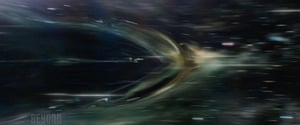
For 50 years the makers of Star Trek have found nifty ways of showing something that literally can not be viewed: faster-than-light travel. Were either in the ship, looking out at some sort of tunnel, or were watching the ship zoom off, leaving behind a warp trail. In Star Trek Beyond, director Justin Lin gives us something new. What we see here is a side-view of the warp bubble that (if I understand it correctly) carves out spacetime to create what is known as subspace. Traveling through subspace is what enables the Enterprise to traverse vast distances in short periods of time. For serious Trek dorks this image is a long time coming, though Im sure someone is on a message board right now saying this isnt what it actually would look like.

1979s Star Trek: The Motion Picture is a divisive film but most fans agree the lengthy sequence of the Enterprise in spacedock is a glorious sight. Star Trek Beyond gives us a playful tweak, making the view of the shipyard more interesting than the ship. Look for the little rectangle of red thats the back of the Enterprise caught up in this enormous tube on a space station.

Here they are: the troika. Captain James T. Kirk flanked by his id and superego, Bones and Spock. This image apes Communist propaganda, which is funny considering the original Star Trek reflected interventionist Kennedy-style American Cold War policy (lets not forget the time Captain Kirk read the Constitution!)
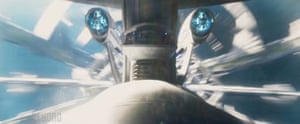
I respect Justin Lin for finding new ways to shoot the Enterprise. It took me a few minutes to figure out if the ship was coming or going in this shot. Its from the front, just a very odd angle. Moreover, the departure from spacedock feels very tactile, almost jarring in a way. Any doubts that the Fast & Furious director wouldnt make his mark are quickly being erased.
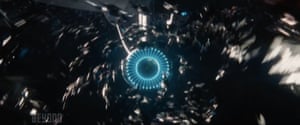
The swarm ships from the last trailer are back, but now they are coming in for the deflector dish. We still dont know if these are mini sentient spacecrafts, nor do we know what they want, but it becomes clear they mean business. Like space piranhas, they tear into the Enterprise, forcing an evacuation.
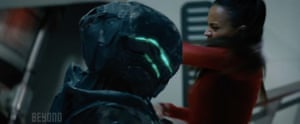
But not before our gang puts up a fight! Heres Uhura kicking ass against some of the baddies that board the ship (its still unclear if these nasty guys come out of the swarm ships, or if the swarm ships clear a path for a larger transport vessel). Either way, it must be said that the villains that Uhura is fighting in this image kinda-sorta resemble the Breen, those enigmatic aliens who wore temperature-controlled suits with glowing green helmets. Im sure they arent, as these reboot films have had very few callbacks to lesser-known creatures from the show, but a fan can hope.

What you are seeing here is terrifying, but likely something of a misdirect. After Captain Kirk orders an abandon ship, we see Chekov (hey, love that guy!) and Sulu (love that guy, too!) get into escape pods. A number of pods fire out into the inky void, and then the camera lingers on one as a swarm ships swoops down and gobbles it up. Its more of a Mothra move than anything from typical Star Trek. Im quite sure it wasnt anyone we know in that pod, but Im certainly ready to bet he was wearing a red shirt.
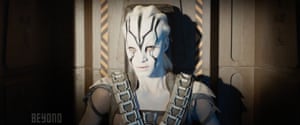
Our crew gets scattered and along the way join forces with this woman named Jaylah. Whats her story? Not sure yet, other than shes ready to fight! Despite some similarities in look, she is probably not from Nibiru, the primitive planet seen at the beginning of Star Trek Into Darkness. Underneath the makeup, Jaylah is played by Algerian-French dancer and actor Sofia Boutella, who you may remember as the henchwoman with swords for legs in Kingsman: The Secret Service.

More space action! But look closely. That doesnt look like the Enterprise. Way too flat, more like Captain Archers NX-01. Some poking around tells me that it is probably the USS Franklin, as some design sketches for this ship have surfaced online. But any more than that is a mystery.
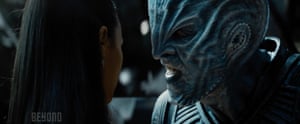
Oh yeah, Idris Elba, one of the best actors working today, is in this movie. Hes the one on the right! Yes, underneath a ton of reptilian makeup. So little is known about his character in this film, other than he is mean. Just look at him being a jerk to Uhura! Boo! His name is Krall and, based on soundbytes, he represents where the frontier pushes back.
This isnt that far removed from the concept of the Gorn, the laughably rubber lizard-man Kirk fought in the Original Series episode Arena. The Gorn were all ticked off at the Federation for having outposts too far into their sphere of influence. But if you watch the behind-the-scenes footage of J.J. Abrams 2009 Star Trek youll see there was a Gorn created for one of the early prison scenes that was cut. So Krall probably isnt a Gorn (plus, Gorn dont speak English, they hiss even with the Universal Translator operative).
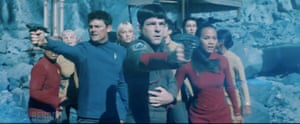
Spock and Bones are down on the planet firing phasers, but there are two noticeable things. One, Spock is wearing overalls? I guess in the context of roughing it while marooned, it is logical. Second, he is clutching his abdomen. Usually in a movie any pronounced overture of being wounded usually means a character is going to croak. I dont know if I have it in me to watch another Spock die in a film, even though they have a tendency to come back to life later. Heres hoping he just had some bad Plomeek soup.
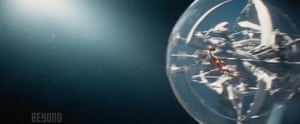
That mysterious ship has returned and this time it is headed to a space station inside some sort of sphere, possibly with an atmosphere. Star Trek has never shown us such a cool looking station before. Between this, images of Jaylah, Krall and those swarm ships, I can safely say that this is already the one of the most visually creative Star Trek films yet. Now we just need to figure out a way to warp to July 22 …




















